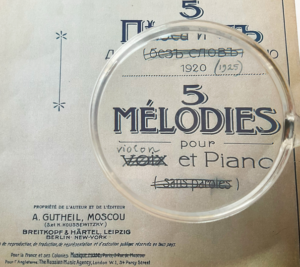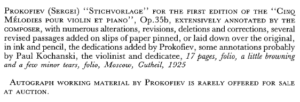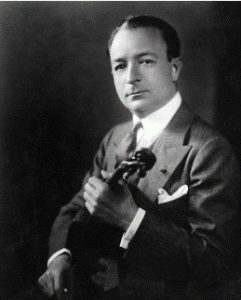Fans of so-called ‘true crime’  formats, reporting, that is, about real criminal cases, know only too well what a major role chance plays in solving crimes. Clues leading nowhere are followed for weeks or months – but then a cross-connection emerges that becomes a hot lead. Or when witnesses are re-questioned, a previously unknown or unnoticed detail turns up, shedding new light on the course of events. In any case, there is often talk of ‘Inspector Fortuity’ when it comes to the breakthrough in solving a criminal case. Although the Henle editorial team’s source research cannot be compared with detective investigations, there are contact points in that sometimes a detective instinct is needed to make the decisive query. Or even – and this is what we’ll be discussing below – Inspector Fortuity is deployed.
formats, reporting, that is, about real criminal cases, know only too well what a major role chance plays in solving crimes. Clues leading nowhere are followed for weeks or months – but then a cross-connection emerges that becomes a hot lead. Or when witnesses are re-questioned, a previously unknown or unnoticed detail turns up, shedding new light on the course of events. In any case, there is often talk of ‘Inspector Fortuity’ when it comes to the breakthrough in solving a criminal case. Although the Henle editorial team’s source research cannot be compared with detective investigations, there are contact points in that sometimes a detective instinct is needed to make the decisive query. Or even – and this is what we’ll be discussing below – Inspector Fortuity is deployed.
In 1920, Sergei Prokofiev composed five ‘Songs without Words’, that is, vocalises, for the singer Nina Koshetz, a close friend at the time. These were published in 1922 as Fünf Melodien für Singstimme und Klavier [Five Melodies for Voice and Piano] Op. 35 and are still performed, though very rarely. The situation is different with their arrangement for violin and piano that Prokofiev undertook in 1925 at the suggestion of violinists Joseph Szigeti, Cecilia Hansen and, above all, Paul Kochański. In this version, the Fünf Melodien are amongst Prokofiev’s most popular chamber music works, having captured a permanent place in the concert repertoire.
For the Henle Urtext edition of the violin-and-piano version, two groups of sources had therefore to be considered: the sources for both the original Opus 35 version, on the one hand, and on the other, for the Opus 35a arrangement. Although the location of the Opus 35 autograph is not known, photocopies preserved in a place well known for Prokofiev research, namely, the Serge Prokofiev Foundation Archive at New York City’s Columbia University, show that the autograph manuscript also served as the engraver’s copy for the first edition. Things were otherwise for a long time with the autograph and engraver’s copy for the violin arrangement – all research into this situation, undertaken by both Fabian Czolbe, editor of the new edition, and also me, as responsible editor, initially came to nothing.
An enquiry to the British Library in London, with reference to the Boosey & Hawkes archive housed there, then brought the breakthrough – and this is where chance comes into play. When Chris Scobie, Lead Curator, Music Manuscripts and Archives, heard that we were planning a new edition of Prokofiev’s Fünf Melodien, he remembered that the British Library possessed an exemplar of the Opus 35 first edition with autograph entries. This, as it soon turned out, was the long-sought source. Without this enquiry and Scobie’s specific tip-off, we would never have known its location. But why did this prominent source location remain unknown in the Prokofiev literature (see Opus 35a)? The answer has to do with the source’s hybrid nature – simultaneously, both print and manuscript. The original 1922 printed version is categorically fundamental, and thus, according to Chris Scobie, the document was catalogued in the British Library until 2017 as a print with a typical shelfmark (K.11.e.23). Only then, in acknowledgement, so to speak, of the manuscript entries, which are not private annotations but compositional notations for an arrangement, was the source assigned to the music manuscripts (with the new shelfmark MS Mus. 1822). Even today, this ostensible engraver’s copy for Opus 35a is easy to overlook, as it appears at first glance in the British Library catalogue as a ‘normal’ first edition of the Opus 35 original version:
 Only when clicking on the title do you discover the reference to the arrangement Opus 35a and the type of source as a manuscript:
Only when clicking on the title do you discover the reference to the arrangement Opus 35a and the type of source as a manuscript:
 Prokofiev obviously did not rewrite the entire music text for the arrangement: aside from a four-measure cut in No. 3, the piano part is only slightly altered, and the vocal part also remains essentially unchanged in its transformation into a violin part. In this respect, it made sense to use an original-edition exemplar as a model for all the changes. Two different hands can be clearly distinguished in the entries: a fine, easily legible transcription, which, as shown from comparisons with other manuscripts, can be attributed to Prokofiev himself, and a rather clumsy, rough hand, coming presumably from the violinist Kochański. Prokofiev made all the inked entries (piano) and part of the pencilled changes (piano, but also violin), the rest were probably made by Kochański (violin only). However, it is not always possible to decide with certainty who wrote one or other of the markings.
Prokofiev obviously did not rewrite the entire music text for the arrangement: aside from a four-measure cut in No. 3, the piano part is only slightly altered, and the vocal part also remains essentially unchanged in its transformation into a violin part. In this respect, it made sense to use an original-edition exemplar as a model for all the changes. Two different hands can be clearly distinguished in the entries: a fine, easily legible transcription, which, as shown from comparisons with other manuscripts, can be attributed to Prokofiev himself, and a rather clumsy, rough hand, coming presumably from the violinist Kochański. Prokofiev made all the inked entries (piano) and part of the pencilled changes (piano, but also violin), the rest were probably made by Kochański (violin only). However, it is not always possible to decide with certainty who wrote one or other of the markings.

Engraver’s copy, Opus 35a, No. 3, mm. 25–27, Pasteover for changes to the piano music and presumably also to the violin music, autograph; ottava and presumably also violin bowings in another hand (Kochański?).
Since documented is that Kochański took over large sections of the vocal part for the violin arrangement, it could well be that Prokofiev drew on Kochański’s drafts for his entries, whereupon, in return, he then notated further changes (including ottava markings, octave markings, double stops, etc.).
But is it even possible to speak of an engraver’s copy? The function of the manuscript entries as a device for publication is not in doubt, though the source lacks the usual publishing-house and engraver’s entries such as plate number or line and page breaks. At least for the latter aspect, however, entries for page breaks were not necessary insofar as the Opus 35 layout could be adopted in editing 14 of the 16 pages (only the cut mentioned in No. 3 led to differing page breaks on pages 10 and 11). Not to be ruled out is that Prokofiev had the source re-copied for an engraver’s copy, especially since comparison with the Opus 35a first edition still shows numerous changes, but this effort seems rather unlikely. Seemingly more plausible is that the London source actually did serve as an engraver’s copy and that the changes mentioned were made in the lost galley proofs. These changes – often refinements to bowing and articulation – reduce this source’s value, but there are still enough dubious passages that can be clarified with its help as an intermediate link between the original version’s first edition and the arrangement’s newly-set first edition. Here is an example:
In the original version’s vocal part, in No. 4, measure 11 (and in the parallel measure 21), the half note g#1 is followed by the quarter note b#:
In the violin arrangement’s first edition, Opus 35a, the sequence in measure 11 is, on the other hand, g#2 – g#1:
The quarter note b# as the leading tone to the following c#1 seems so plausible that the g#1 in m. 11 could be considered a printing error, especially as the leading tone is preserved in the parallel passage (merely shifted an octave higher than the sequence b#1–c#2). However, the corresponding passage in the London source shows that b# was deliberately changed to g#1 and that the first edition is therefore correct:
The ownership of the source can, alas, be only incompletely traced. Prokofiev himself may even have given it away to Kochański after the arrangement had appeared in print. According to Chris Scobie’s research, it was offered for sale at Sotheby’s in 1990 at the latest, with explicit reference to the document’s rarity:
 The British Library acquired the source five years later from the Lisa Cox Music Ltd. catalogue – determining who previously possessed it is no longer possible, though it is reassuring that the source is now in the public domain, and that chance has ensured that the new Urtext edition (HN 1539) soon to be published will be based on all available sources.
The British Library acquired the source five years later from the Lisa Cox Music Ltd. catalogue – determining who previously possessed it is no longer possible, though it is reassuring that the source is now in the public domain, and that chance has ensured that the new Urtext edition (HN 1539) soon to be published will be based on all available sources.




